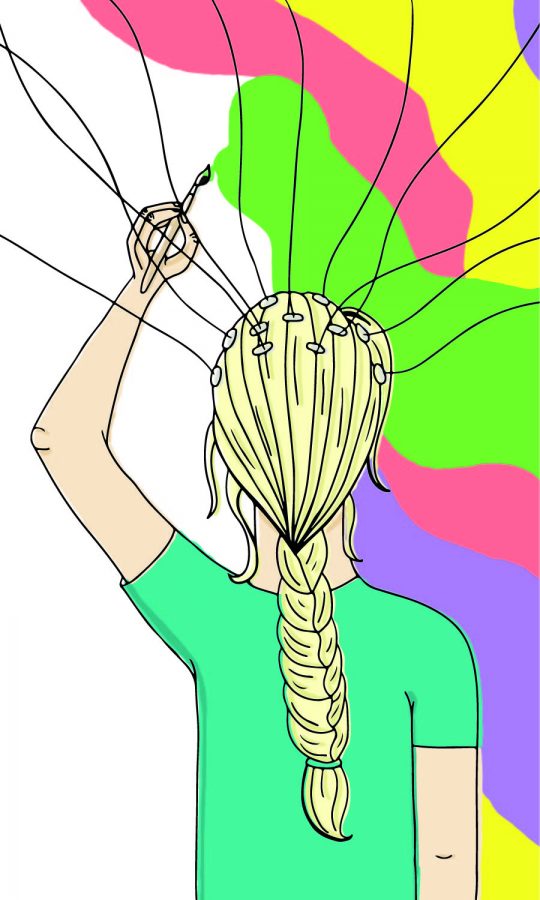Electric current ups creativity
Electric current ups electricity
April 27, 2015
As waves of electrical current sweep across the folded gray matter in your skull while you imagine, feel or experience emotions, your brain is literally storming.
In an April 1 study published in the journal Cortex, researchers from the University of North Carolina’s School of Medicine applied a low-level electrical charge to the brains of study participants, merging an external and non-invasive source of current with the naturally occurring waves that flow through the human brain.
Individuals received transcranial alternating current stimulation via electrodes on their heads while researchers administered the equivalent of an IQ test for creativity. They specifically targeted alpha waves in the brain, which naturally occur within an eight- to 12-hertz frequency, using an alternating 10-hertz current, which produced a notable increase in creativity.
“This study was a stepping stone toward the ultimate goal,” said Flavio Frohlich, Ph.D., co-author of the paper and an assistant professor of psychiatry at UNC’s School of Medicine. “In this case the ultimate goal is to treat mood disorders such as major depressive disorder or depression. There are a lot of studies that show pathological changes and deficits in alpha oscillations in patients with depression.”
Although certain patterns of electrical activity in the brain are associated with certain behaviors or cognitive abilities, Frohlich said it is difficult to pin down the definitive source. Using non-invasive methods such as EEG to measure excitement in different parts of the brain may just represent byproducts of brainstorming or concentrating rather than their biological points of origin. Brain stimulation research has mostly just been able to illustrate the association rather than establish a causal link.
“If we can show that creativity changes by targeting alpha oscillations, then we’ve established a functional role for the alpha waves in that process,” Frohlich said. “We haven’t demonstrated that 10-hertz tACS treats depression, but we’ve demonstrated that with 10-hertz stimulation, we can modulate a very complicated cognitive process that we know is driven by [certain brain waves].”
Vincent Clark, Ph.D. and director of the Psychology Clinical Neuroscience Center at the University of New Mexico, said his laboratory has published research in which patients diagnosed with illnesses such as schizophrenia and addiction experienced relief from their symptoms using transcranial direct current stimulation, a constant low-level application of electricity, rather than an alternating charge.
“We’ve looked at reducing auditory hallucinations in patients with a diagnosis of schizophrenia,” Clark said. “Reducing drinking in people who have yet to be labeled alcoholics but are headed in that direction, reducing smoking in people who want to give it up but can’t do it on their own.”
According to Clark, a number of factors could be influencing what happens when the brain is stimulated by a low-level electrical current, and researchers do not exactly know what the main driver is. However, this is also the case for more established, mainstream forms of treatment.
“We think we understand how antidepressants work generally, but in detail we don’t,” Clark said. “[Brain stimulation] is no different. We just know it produces a change in behavior. That is undeniable.”
There are two sides to those behavioral changes, Frohlich said. One side is the treatment of individuals with debilitating diseases whose quality of life is severely impacted by impaired cognition. Depending on the mood, neurological or psychological disorder, there may be a relatively effective medication, but those interventions do not exist for the cognitive deficiencies.
“The other side is cognitive enhancement in healthy individuals, and I think this is a very difficult area,” Frohlich said. “There are lots of reasons to be cautious about that. There are lots of implications, the same as performance-enhancing drugs in sports. It’s a very complicated ethical question.”
Some brain stimulation research shows that, over time, the therapy can generate changes in brain plasticity, causing the brain to retain the changes it sustains from the electrical intervention, according to Sangeetha Madhavan, Ph.D., an assistant professor in the Department of Kinesiology and Nutrition at the University of Illinois at Chicago. Her lab has applied the technique to stroke patients, demonstrating improvements in motor function when tDCS is combined with physical therapy.
“When looking at stroke recovery and the effect of [tDCS], using the current in combination with some kind of therapy improved function much better than therapy alone,” Madhavan said.
Madhavan said that by applying the current externally, researchers hope to prime the brain, signaling that it should be prepared to receive therapy for whatever nerve damage it sustained. Similarly to psychological symptoms of traumatic mood disorders, impaired motor function is associated with certain parts of the brain but is reflected across many regions.
“It changes the excitability of the neurons, make them more active—and this is just within one session,” she said. “tDCS is not very focused. We don’t know if it’s actually activating areas under the current, but there has been plenty of modeling that suggests it is activating those areas.”
Frohlich said the research is far from demonstrating brain stimulation being used as an alternative to current treatments but that the method could one day become a lower-risk and cheaper option for patients, eliminating the side effects of medications and the discomfort of invasive procedures.
“We live and dream and think and suffer through electrical activity patterns in the brain,” Frohlich said. “We should find a gentle but productive way to interact with these electric activity patterns through electric stimulation. The big vision and the dream is this will be the next generation of therapeutics.”








